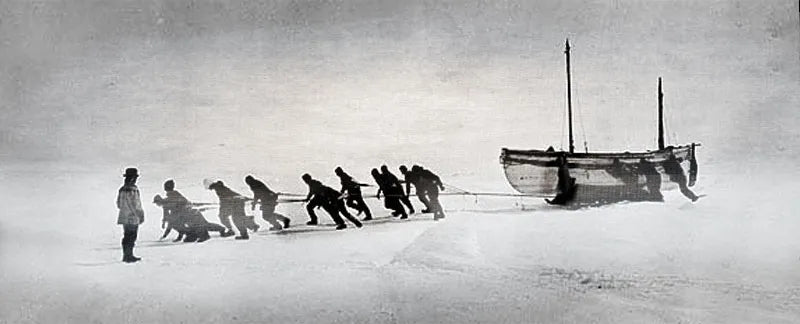Tom Crean was a giant of man, from Annascaul, Co.Kerry. He was one of the few men to explore the Antarctic with both Scott and Shackleton and was deeply respected by both men.
Departing his family farm at the age of 15 following a disagreement with his parents, Tom embarked on a journey almost incomrehensible by modern standards. Fudging his age, he enlisted in the British Navy and volunteered for exploratory missions in 1901, becoming an integral part of the renowned "Heroic Age of Antarctic Exploration."

During his second tour to Antarctica on the Terra Nova expedition with Captain Scott, after man-hauling a sledge for an unfathomable 1500 miles for 100 days (about the distance from London to Moscow), Tom Crean volunteered to make a solo 35-mile trek, on foot (having ditched his skis and sledge), with only 3 crackers and a stick of chocolate, in brutal -30c (-22F) temperatures, across the Ross Ice Shelf to save his dying friends – Evans & Lashley.
Crean somehow completed the march in 18hrs and to this day, the act is widely recognised as the single most selfless act of courage in the history of exploration.

On perhaps his most famous and awe-inspiring expedition, he joined Sir Earnest Shackleton as Second Officer on the Endurance expedition. After his ship, became encased in pack ice and sank, he was a participant in a dramatic series of events including months spent drifting on ice, a journey in lifeboats to Elephant Island, and an open boat journey of 800 nautical miles (1,500 km) from Elephant Island to South Georgia. Upon reaching South Georgia, Crean was one of the party of three which undertook the first land crossing of the island, without maps or mountaineering equipment to get aid.

The open boat journey of 800 miles in the tiny James Caird lifeboat, is hailed as the greatest sea journey ever made, this stretch of sea has claimed many lives, in much larger and better-equipped ships and was all the more remarkable given it was navigated solely with a sextant and a watch. Even half a degree off course, Crean and the men faced certain death as the next land mass would have been Africa.

As the tiny lifeboat made its way across the convulsive Weddell Sea, and the weary six-man crew struggled to cope with numerous dangers, hunger, cold and unrelenting soakings, sometimes Tom Crean would sing, especially when he would take up his shift at the boat’s tiller.
Crean’s singing has been mentioned in many Polar memoirs, and none allude to anything other than the fact that he was not particularly adept at it, though it did in some strange way help raise his comrade's morale. During moments of intense peril or indeed at times when some of the men's spirits were starting to flag, Crean’s crooning would begin.
Below is Sir Ernest Shackleton’s take on Crean’s singing:
“One of the memories that comes to me from those days is of Crean singing, and nobody ever discovered what the song was. It was devoid of tune and as monotonous as the chanting of a Buddhist monk at his prayers, yet somehow it was cheerful. In moments of inspiration, Crean would attempt The Wearing of the Green.”

Through these arduous expeditions, Tom Crean solidified his reputation as a tenacious and reliable polar traveller, earning three Polar medals and the Albert Medal for Lifesaving. After serving in the Navy during World War I and concluding his naval career in 1920, he returned to Kerry.
In Annascaul, Crean tied the knot and established a modest pub known as the "South Pole Inn." Renowned for his humility, he stowed away his medals and refrained from discussing his remarkable achievements or granting press interviews. His medals and sword found their place in a box, marking the end of his exploring career.

Having endured some of the harshest conditions known to man, Tom Crean's life was cut short by appendicitis in 1938 at the age of 61. He found his final resting place in a family plot in Ballynacourty. While for a time he was almost forgotten in the annals of Antarctic exploration, recent years have seen a resurgence of interest in his role in the Endurance Expedition. His story epitomises survival against all odds, unrelenting optimism and determination to always Make Progress.
At our core, Nomadic Watches, are inspired by extraordinary narratives and the remarkable individuals behind them. Stay tuned for more updates on our exciting new model, the Turas 914, which pays tribute to the feats of the incredible characters behind the 1914 Trans-Antarctic expedition.





